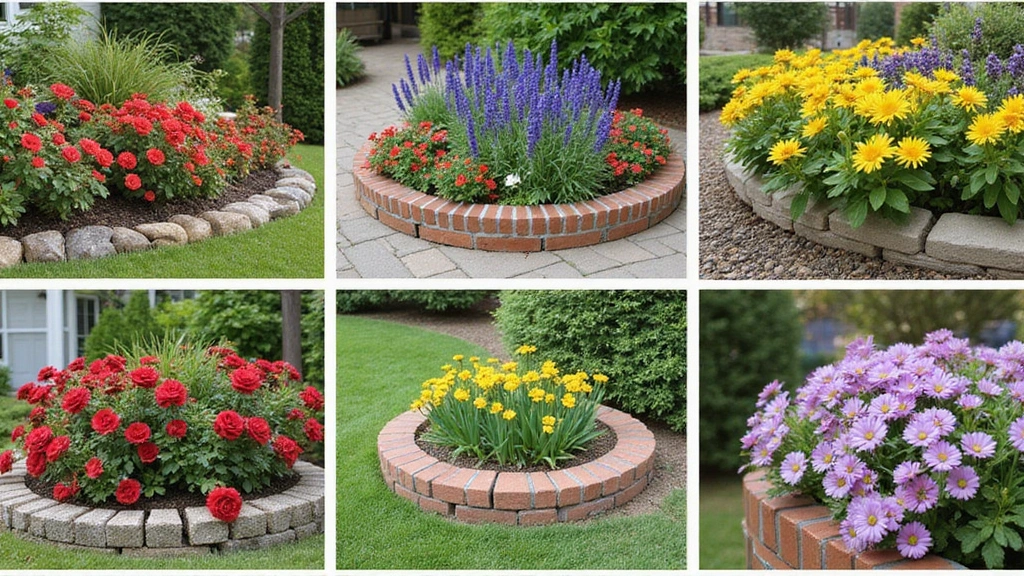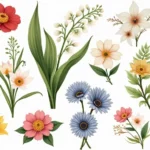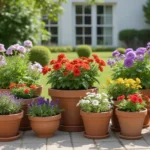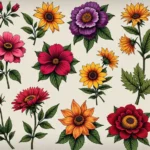Transforming your garden doesn’t have to break the bank!
When it comes to creating beautiful flower bed borders, there are countless ways to achieve a stylish look while sticking to a budget.
From repurposed materials to DIY projects, there are innovative and affordable options that can uplift the aesthetics of your garden.
In this list of over 30 cheap flower bed edging ideas, you’ll find a treasure trove of inspiration that encourages you to get crafty and resourceful without spending a fortune!
1. Upcycled Wooden Pallets
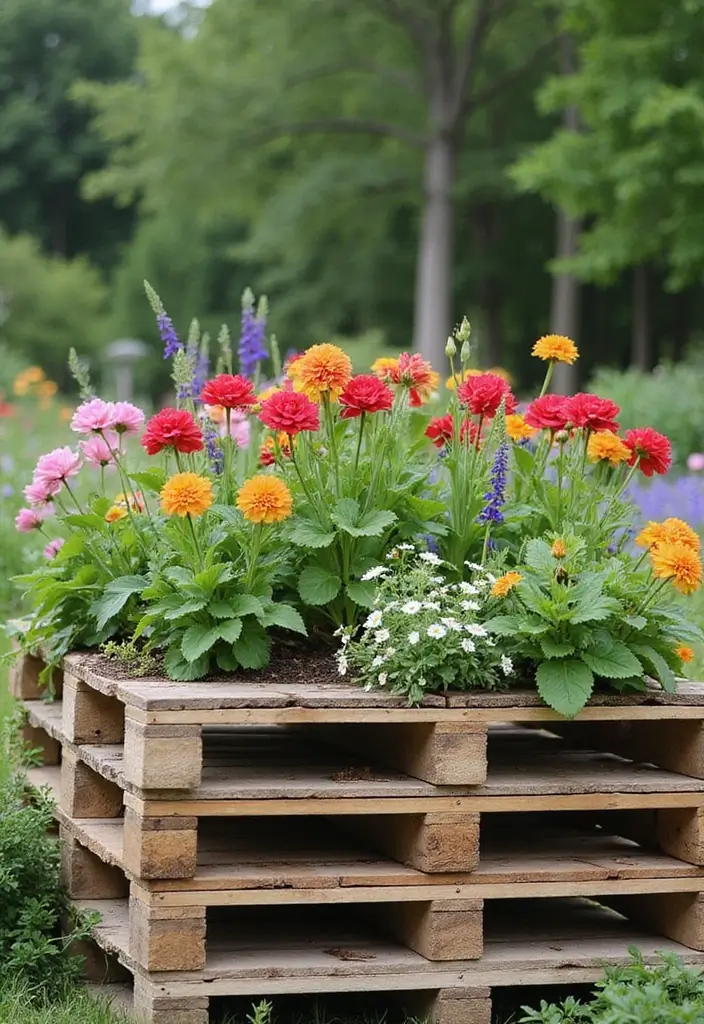
Old wooden pallets can be a gardener’s best friend!
They provide a rustic, charming look when used to frame your flower beds. To make this edging, you can cut the pallets into various sizes depending on your desired height and shape.
Why choose pallets? They are often free or very cheap, and they add character to your garden. Just be sure to sand down any rough edges to avoid splinters.
Tips: You can paint them in bold colors or keep the natural wood finish, depending on your garden’s vibe.
Pro Tip: Stack two pallets for added height or angle them to create a unique shape. They can also be used to create raised beds, giving you double the functionality.
With creativity, pallets can elevate your outdoor space while keeping costs low!
2. Stones and Pebbles

If you’re looking for a natural yet elegant option, consider using stones and pebbles.
These materials can be found in nature or purchased cheaply at local garden centers.
Arrangement ideas: Lay larger stones as the main border and fill in gaps with smaller pebbles. This not only looks beautiful but also helps with drainage and weed control.
Maintenance: Stones are low-maintenance, requiring little to no upkeep compared to traditional wood.
Unique Insight: Combining different sizes and colors can create a visually stunning effect. You can even add some mosaic patterns for a personal touch.
Overall, stone edging is a timeless option that screams style without the hefty price tag!
3. Bricks from Old Pathways

Repurposing bricks from old pathways is not only eco-friendly but also creates a charming look.
Bricks can be laid flat or on their sides, depending on how tall you want the edging to be.
Benefits: They’re durable and can withstand the elements, making them a long-lasting choice for flower bed borders.
Creative Tip: Mix and match different types of bricks for a unique aesthetic. You can even paint them if you want a pop of color!
Consider: If your bricks are uneven, consider leveling them with sand to create a smooth, clean edge. This can prevent tripping and give your garden a polished look.
With bricks, you can create a classic garden fence that marries functionality and style!
4. Tires: A Colorful Twist

Old tires can be transformed into whimsical flower bed borders!
Paint them bright colors to add fun and vibrancy to your garden. You can cut them in half or use them whole, depending on your style.
Why tires? They are incredibly durable and can create a unique look that sets your garden apart.
Usage advice: Make sure to clean them well before painting to ensure the color adheres properly.
Pro Tip: Stack them to create height or use them to form curves and shapes in your garden bed. You can even add soil and plant directly within them for a unique planter look!
Tires may seem unconventional, but they can enhance your garden’s personality without costing a fortune!
5. Bamboo Stakes

For a natural look, consider using bamboo stakes as edging.
Bamboo is not only affordable but also incredibly strong and flexible, making it an excellent choice for flower bed borders.
How to use: Simply drive the stakes into the ground at regular intervals along your flower bed. This creates a subtle separation that’s perfect for showcasing your plants.
Tip: You can also tie together pieces of bamboo with twine for a more cohesive look.
Advantage: Bamboo blends seamlessly into any garden setting and is biodegradable, adding to its eco-friendly appeal.
Using bamboo stakes is an easy DIY project that gives your garden a neat, organized appearance without a hefty investment!
6. Wine Bottles
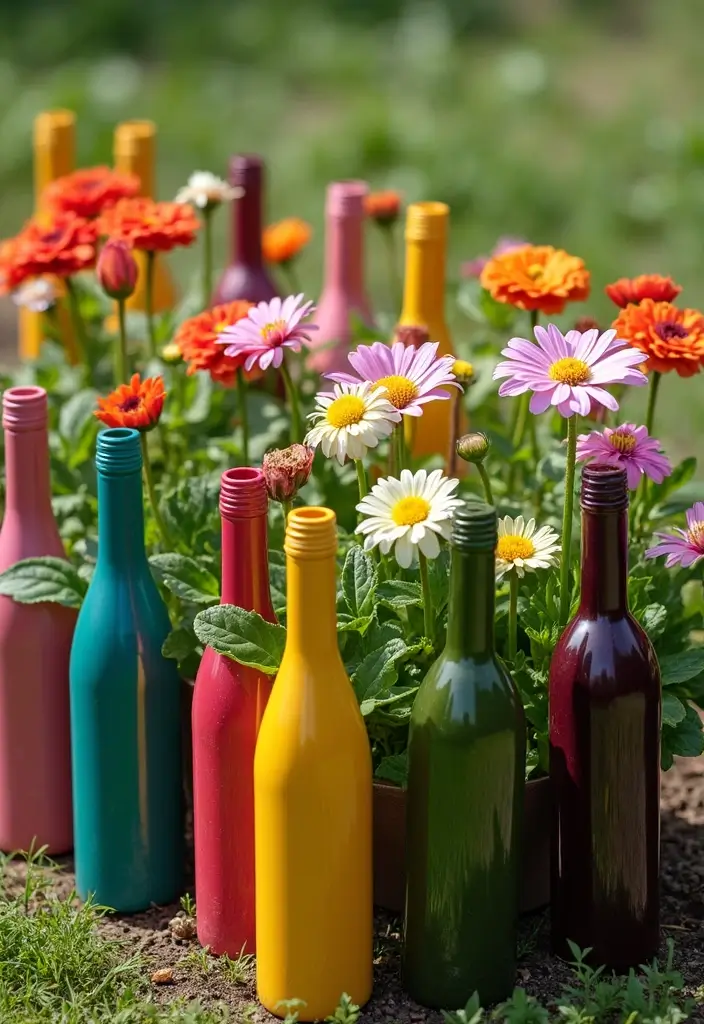
Give your empty wine bottles a new life as a unique flower bed border!
Use them upright to create a fun, colorful edge, or lay them down for a more understated effect.
What’s great: They add a playful touch while being an eco-friendly option. Choose a mix of colored and clear bottles for an eclectic look.
Installation tip: If you’re using them upright, bury a portion of the bottle in the soil for stability. You can even create a spiral pattern for added visual interest.
Consider: Check your local recycling rules about using glass in gardens, as some areas may have restrictions.
This creative idea not only saves you money but also gets your guests talking about your garden’s charm!
7. Concrete Blocks
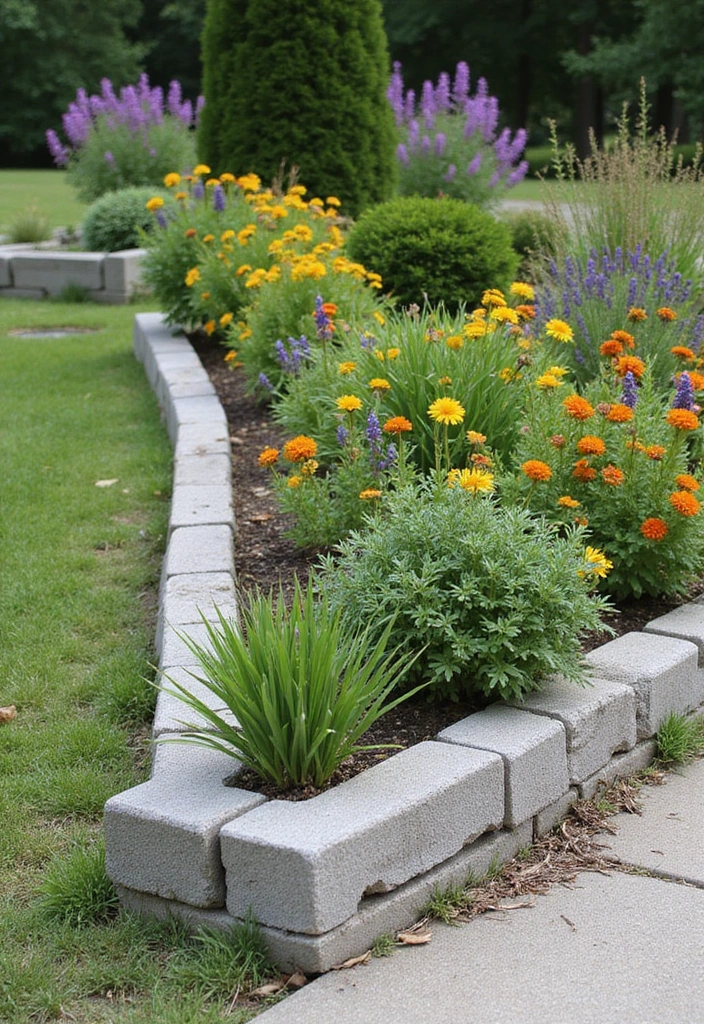
Concrete blocks are a versatile and sturdy option for edging your flower beds.
You can paint them or leave them bare, depending on your garden’s theme.
Installation: Place the blocks side by side or stack them for added height. You can also create a small wall for a more defined boundary.
Unique advantage: The hollow centers of the blocks can be filled with soil and planted directly with succulents or other small plants, making them both functional and decorative.
Pro Tip: For a more natural look, consider adding a few climbing plants to spill over the edges.
Concrete blocks are not just practical; they’re a blank canvas for your creativity!
8. Recycled Plastic Bottles

Transform recycled plastic bottles into a budget-friendly flower bed border!
Cut the bottles in half and bury the top half slightly in the soil, leaving the spout exposed. This creates a whimsical, colorful edge that deters weeds.
Why opt for plastic? They are lightweight, won’t rot, and can be painted to match your garden’s theme.
Creative Tip: You can use different sizes and shapes to create a more dynamic look.
Maintenance: Minimal upkeep is required, just ensure the edges stay clean to maintain a tidy appearance.
This eco-friendly option not only saves money but gives a unique flair to your garden!
9. Decorative Fencing
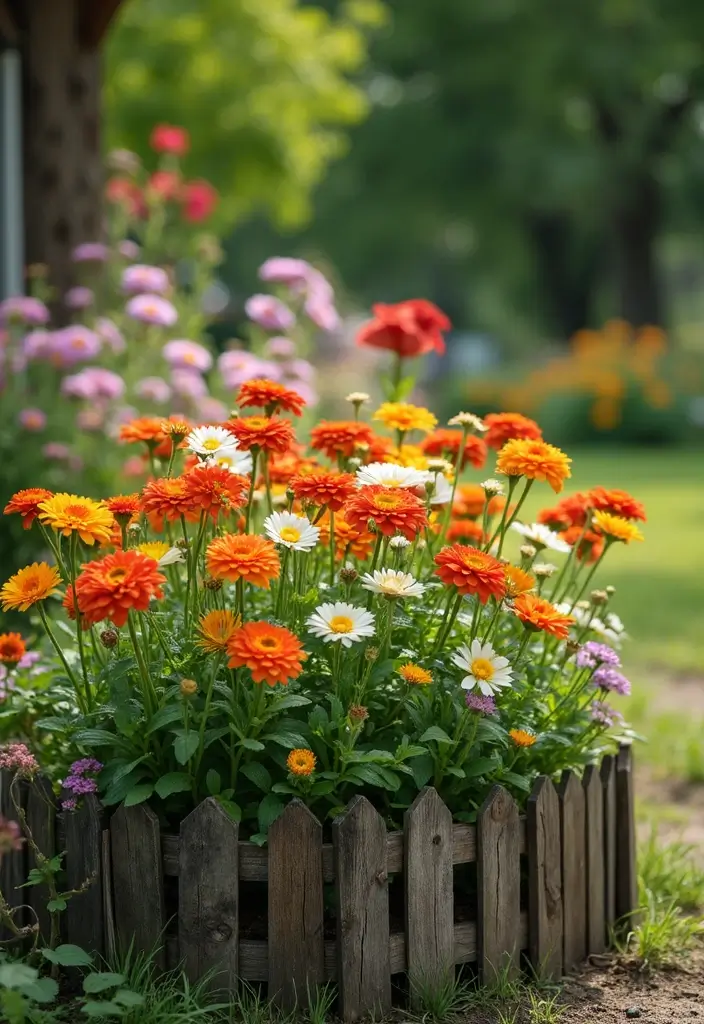
If you want a defined border without spending much, consider decorative fencing.
You can find affordable options at garden stores or even make your own using repurposed materials.
Material choices: Wood, metal, or plastic can all work well and can be painted or stained to match your garden aesthetics.
Style tips: Choose a design that complements the overall look of your garden, whether that be rustic, modern, or whimsical.
Installation: Simply secure them into the ground at regular intervals to create a clean edge.
Decorative fencing not only keeps your plants contained but also adds a polished finish to your outdoor space!
10. Logs and Branches

Using logs and branches as edging provides a natural, rustic look.
You can lay logs horizontally around the bed or even stack them for a more defined edge.
Benefits: They blend seamlessly into the garden and can often be found for free, especially if you have a yard with trees.
Tip: Ensure they are dry and free of pests before using them. You can also treat them with a wood preservative to extend their lifespan.
Creative twist: Combine different sizes and shapes to give your flower beds a unique character.
This is a budget-friendly and eco-friendly option that adds warmth and charm to your garden!
11. Fabric Landscape Edging

If you’re looking for a cost-effective yet stylish border, fabric landscape edging is a fantastic choice.
This option is not only budget-friendly but also allows for easy installation and maintenance.
How to use: Cut the fabric to your desired length and shape, then stake it down around your flower bed.
Advantage: It controls weeds and grass while allowing water to filter through, keeping your plants healthy.
Customization: You can layer fabric with rocks or mulch for added texture and color.
This option is both practical and visually appealing, offering a neat appearance without the hefty price tag!
12. Vintage Door Frames

For a truly unique flower bed border, consider using old door frames!
They add an element of surprise and creativity to your garden design.
Installation tips: Simply secure the door frame into the ground or set it tilted for an artistic flair. You can paint it in bold colors for a modern twist or keep it rustic for a farmhouse feel.
Benefits: They are typically inexpensive or even free if you have any lying around.
Pro Tip: You can also grow climbing plants on the frame for an enchanting vertical garden effect.
Using door frames gives your garden a whimsical touch while showcasing your personality!
13. Cinder Blocks
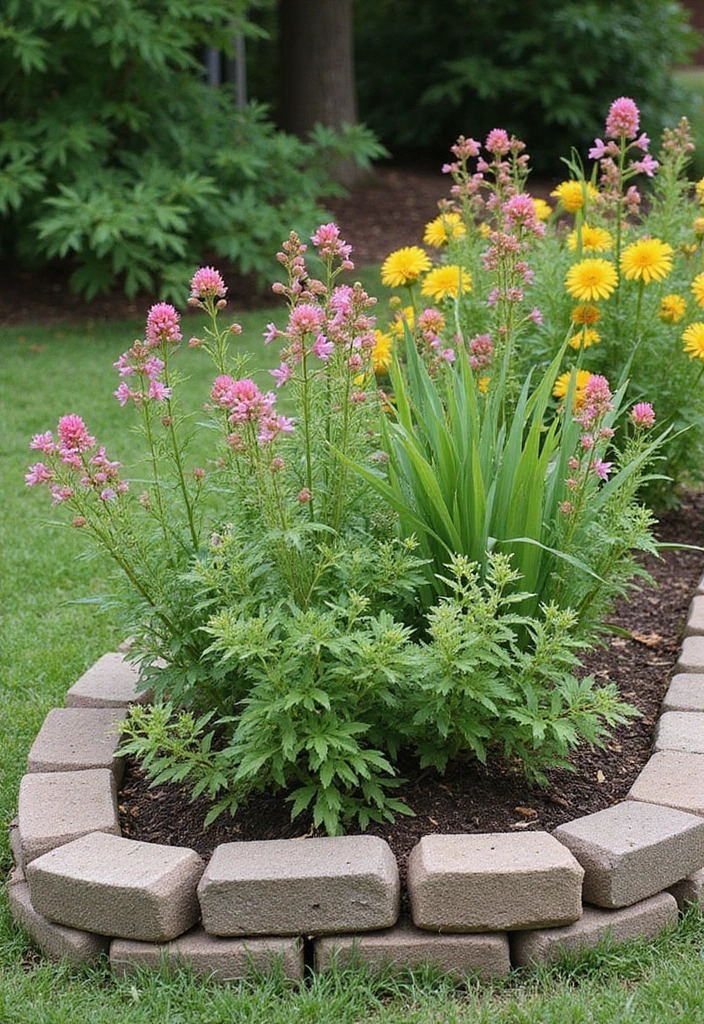
Cinder blocks are another affordable and versatile option for flower bed edging.
You can leave them raw for a rustic look or paint them for a more modern appeal.
Practical uses: Stack them to create elevation or use them as a base for planting. The cavities can be filled with soil for small plants or even herbs.
Installation advice: Ensure they are level for a tidy appearance, which also adds to the safety of your garden.
A unique addition could be adding a layer of ground cover plants to spill over the edges.
Cinder blocks offer endless possibilities for both aesthetics and functionality!
14. Repurposed Wood Crates
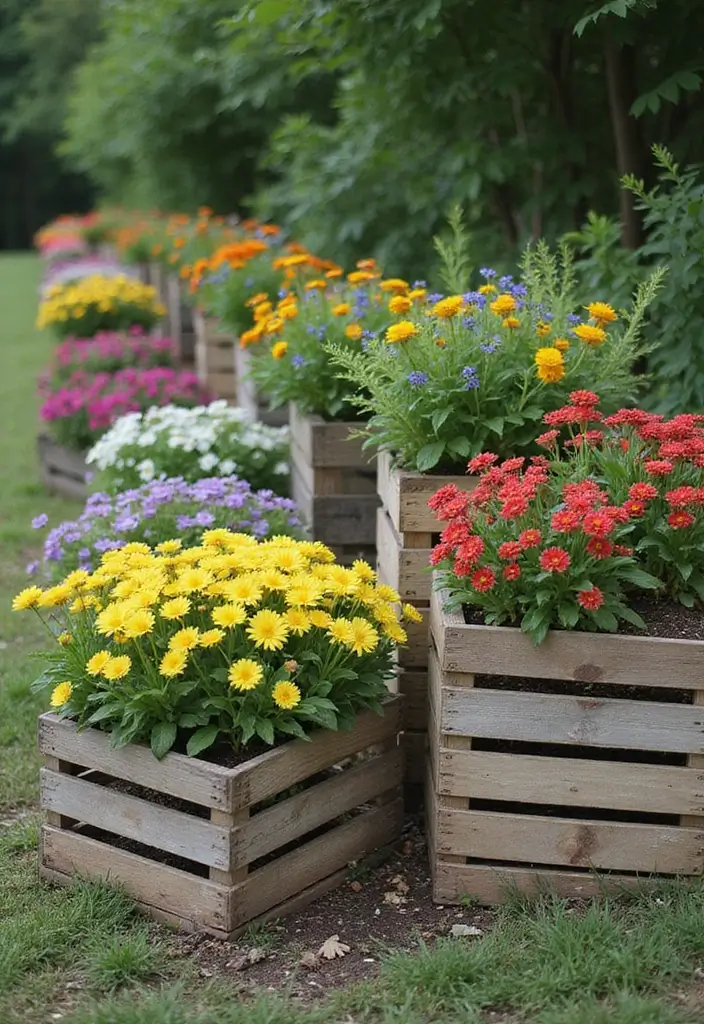
Old wooden crates can serve as a charming flower bed border that is both affordable and appealing.
Arrange them upright around the flower bed or lay them flat for a more defined edge.
Advantages: They add character and can often be found at thrift stores or garage sales. You can also paint or stain them to match your garden’s theme.
Creative Tip: Use the inside of the crate for planting, giving you double the functionality.
Placing them at different heights can also create a visually interesting flow within your garden design.
This is a great way to keep costs low while still making a statement!
Transforming old wooden crates into charming flower bed edges not only saves you money but also adds unique character to your garden. Embrace creativity and watch your garden bloom with personality!
15. Edging with Overturned Pots
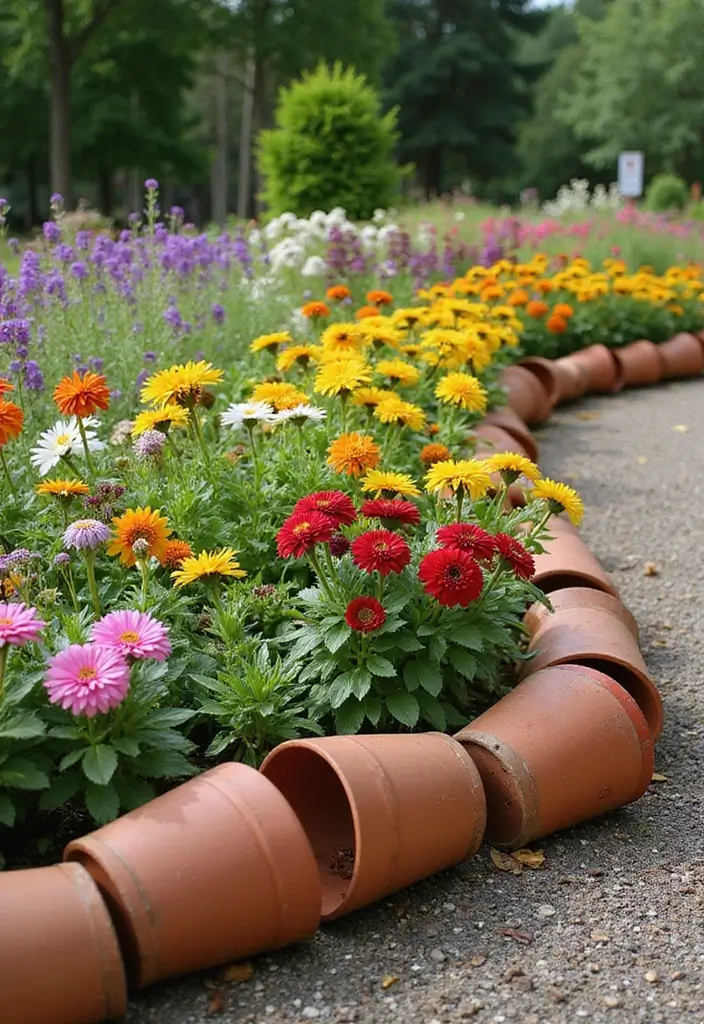
Give a playful twist to your flower beds by using overturned pots as edging!
This quirky idea adds a touch of whimsy and can be completed in just a few minutes.
How to do it: Gather some old, mismatched pots and arrange them upside down around your flower bed. This creates a unique texture and interesting silhouette.
Benefits: It’s inexpensive, and you can often find pots in thrift stores or even your own garage.
Pro Tip: If you have a colorful collection, it can turn into a fun focal point in your garden.
Using overturned pots as edging brings creativity and charm to your flower beds without spending much!
Transform your garden with playful, upside-down pots! This simple, cheap flower bed edging idea adds charm and personality in minutes. Embrace creativity and make your garden uniquely yours!
16. Chicken Wire and Stones
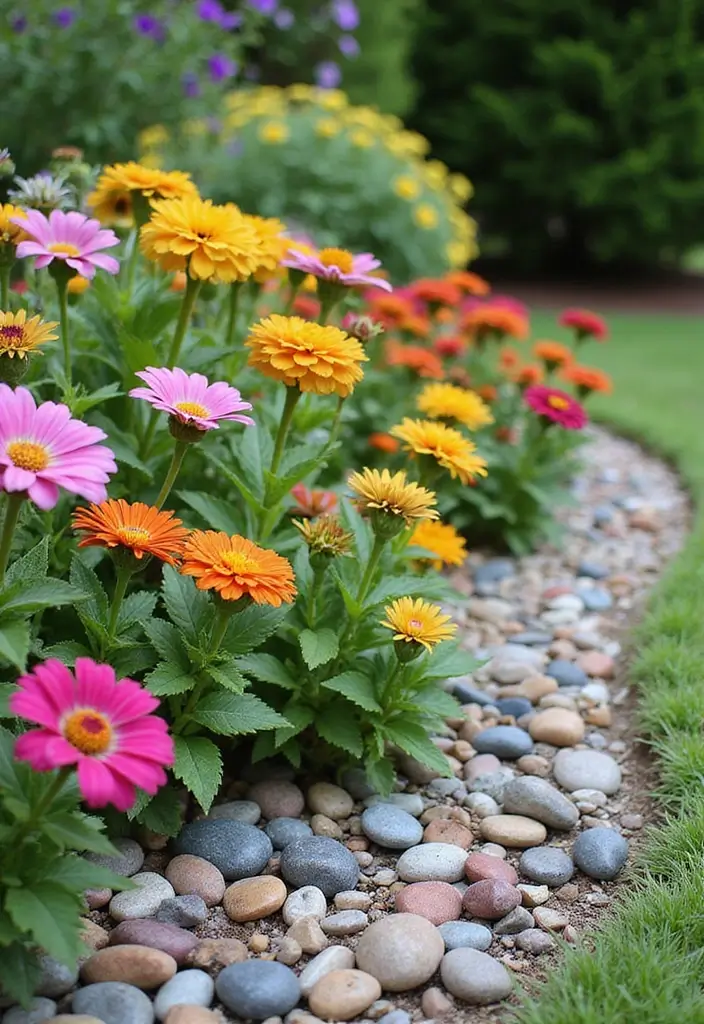
For a modern, rustic edge, consider using chicken wire filled with stones.
This option is not only stylish but also functional, helping to keep out weeds while allowing for proper drainage.
How to create: Form the chicken wire into a desired shape and fill it with medium-sized stones.
Benefits: It’s budget-friendly and can be customized in height and width based on your garden layout.
Creative inspiration: You can even add climbing plants to the wire for added texture and interest.
This innovative approach offers a clean, contemporary look while still being practical!
17. Seashells and Driftwood
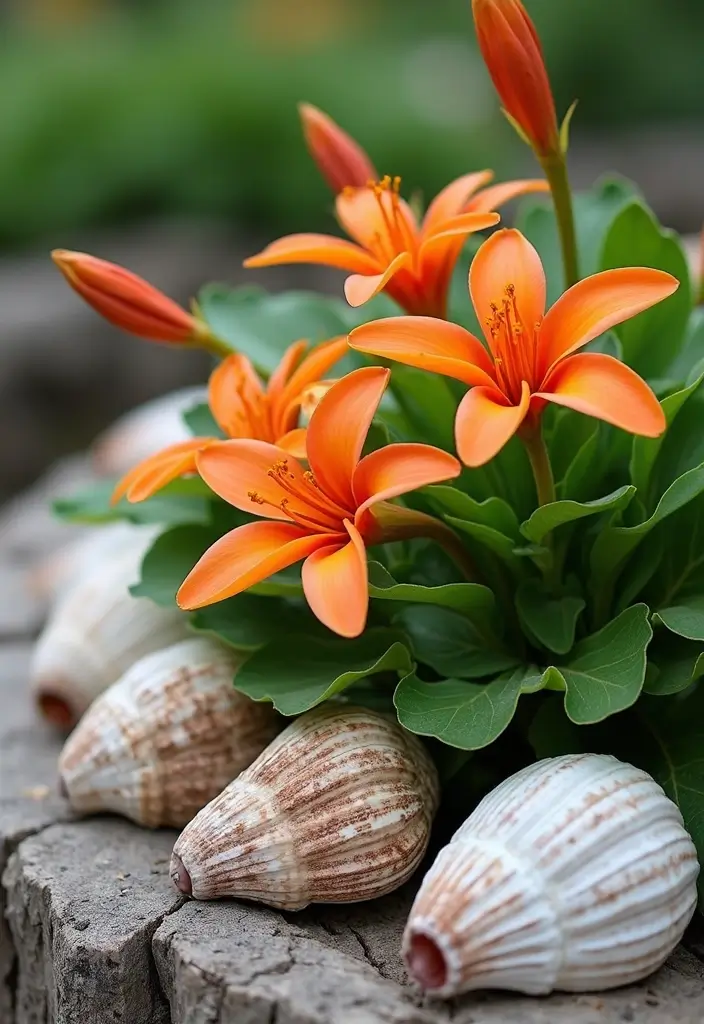
If you live near the coast or love beachy vibes, using seashells and driftwood as edging is a delightful option.
Arrange the driftwood along the edge of your flower bed and use seashells to fill in gaps.
Benefits: This low-cost option adds a unique aesthetic and brings a bit of nature into your garden.
Installation tips: Make sure the driftwood is cleaned and free from pests. You can also use it as a natural stake for climbing plants.
A seashell border can add a whimsical, ocean-inspired feel that’s sure to impress visitors.
This creative idea can transform your flower bed into a coastal paradise!
18. Fabric Strips

Using fabric strips as an edging option can create a soft, colorful boundary for your flower beds.
You can utilize old sheets or fabric remnants, cutting them into strips and weaving them into the soil at the edges.
Benefits: This approach is inexpensive and gives your garden a unique touch. Plus, it’s perfect for those who love to sew and repurpose materials.
Creative twist: Choose fabric with vibrant patterns or colors to match the flowers in your bed.
Regularly check the condition of the fabric, as it may eventually need replacing, but it’s a fun way to recycle materials while keeping things stylish!
19. Pallet Wood Slats

Pallet wood slats offer a clean and rustic border for your flower beds.
Simply cut the slats to your desired height and arrange them in a neat line. They can be left natural, stained, or painted to match your garden style.
Advantages: They’re often free or very cheap, making this a budget-friendly option that also adds character.
Pro Tip: For a more modern look, consider spacing the slats evenly to create visual interest.
Pairing this with low-maintenance plants can create a stunning and efficient garden space without a high cost!
20. Garden Hoses
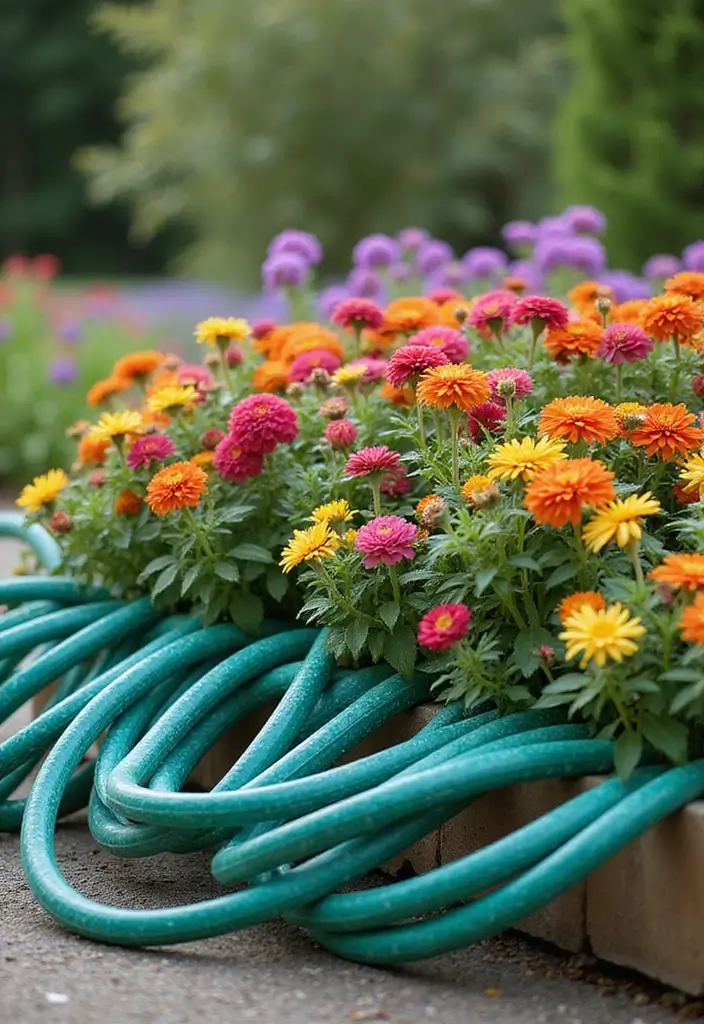
An innovative way to create a border is using old garden hoses!
Lay the hose in a circular or curved pattern around your flower bed for a unique and flexible edge.
Why hoses? They are often discarded but can be repurposed creatively!
Tips: Cut the hose to fit your design, or create patterns. You can use stakes to secure it in place.
This option is both affordable and adds a quirky twist to your garden design.
Using hoses not only keeps your flowers contained but also showcases your creativity in a delightful way!
21. Wooden Planks
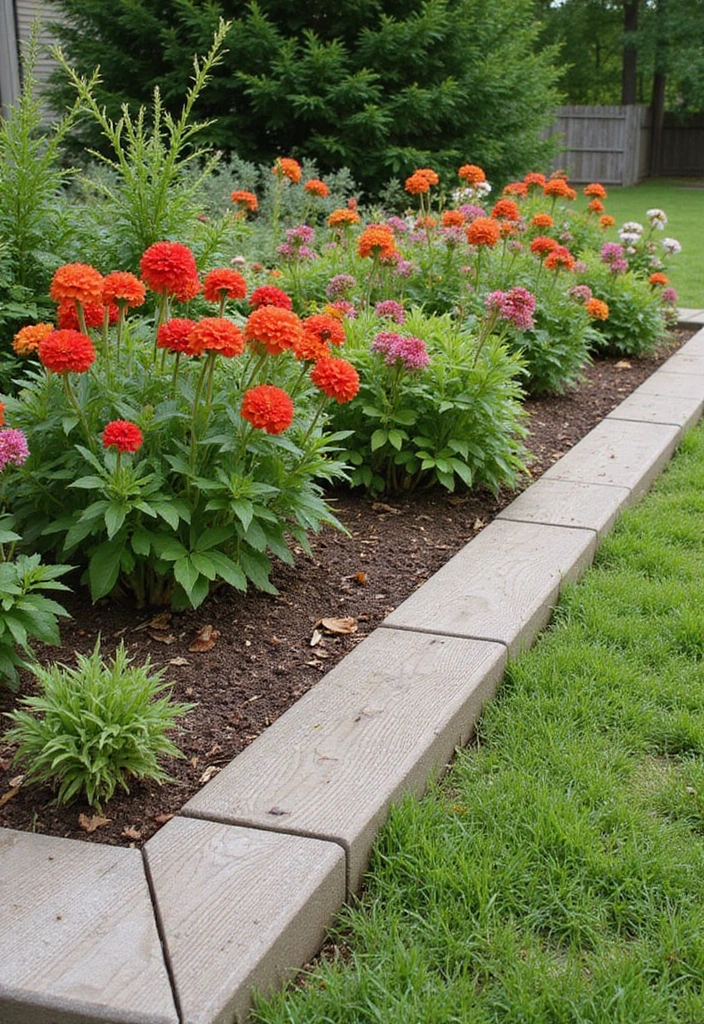
For a simple yet effective border, wooden planks can be an excellent choice.
You can cut them to whatever length you need and stain or paint them to fit your garden style.
Advantages: This option is highly customizable and allows for various configurations, from straight lines to curved edges.
Installation tip: Secure the planks in place with stakes for a sturdier finish.
Planks can also be painted in fun colors to match the mood of your garden!
Using wooden planks adds a clean and polished look that enhances your flower beds without much expense.
Transform your garden with wooden planks – they’re customizable, sturdy, and effortlessly stylish! Whether you prefer straight lines or playful curves, edging doesn’t have to break the bank!
22. Cardboard Edging
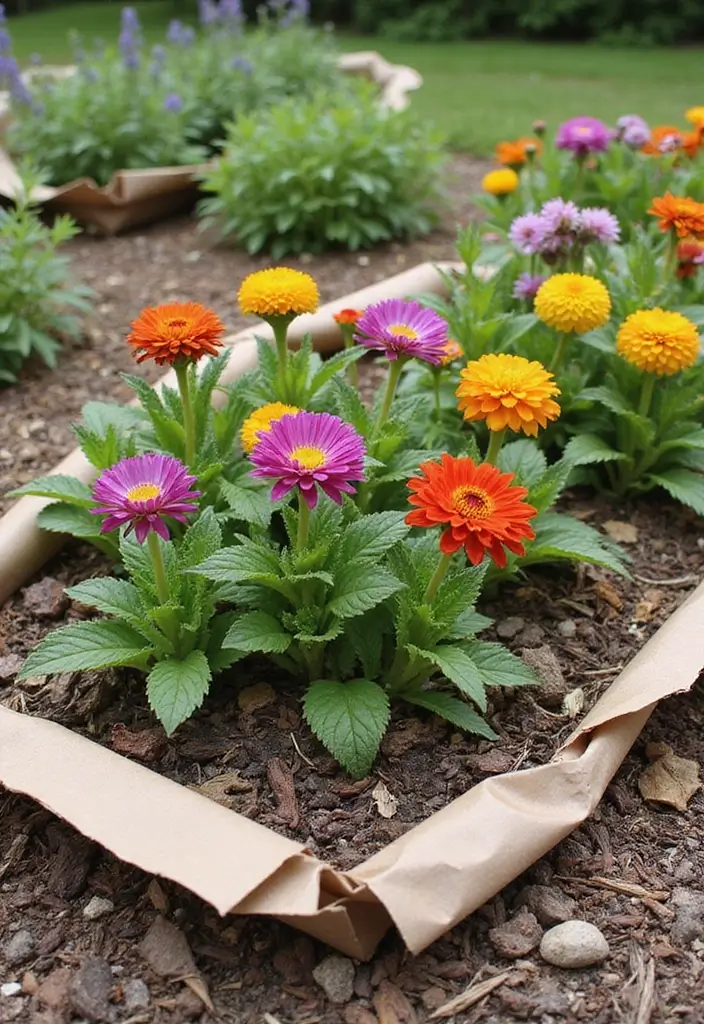
For a truly budget-friendly option, consider using cardboard as edging.
Lay down cardboard around your flower bed to suppress weeds and enrich the soil as it decomposes.
Why cardboard? It’s free, eco-friendly, and helps improve soil health while holding moisture.
Tip: Ensure to cover the cardboard with mulch for a more finished look and to keep it intact.
In time, the cardboard breaks down, making it a fantastic choice for those looking to improve their garden naturally.
This option is not only cost-effective but also supports sustainable gardening practices!
23. Leaf Litter Edging

Using leaf litter as a border is an environmentally responsible choice!
Simply gather fallen leaves and create a slight mound around your flower bed.
Benefits: It’s free, helps with weed control, and adds nutrients to your soil as it breaks down.
Installation tip: Choose a mix of leaves for varying textures and colors.
Consider this option particularly in the fall when leaves are plentiful.
Leaf litter brings a natural, organic feel to your garden while being incredibly budget-friendly!
Nature provides the best edging for your garden! Gather fallen leaves and create a stylish, nutrient-rich border that’s free and eco-friendly. Transform your flower beds with leaf litter for a beautiful, organic touch!
24. Scrap Metal Edging
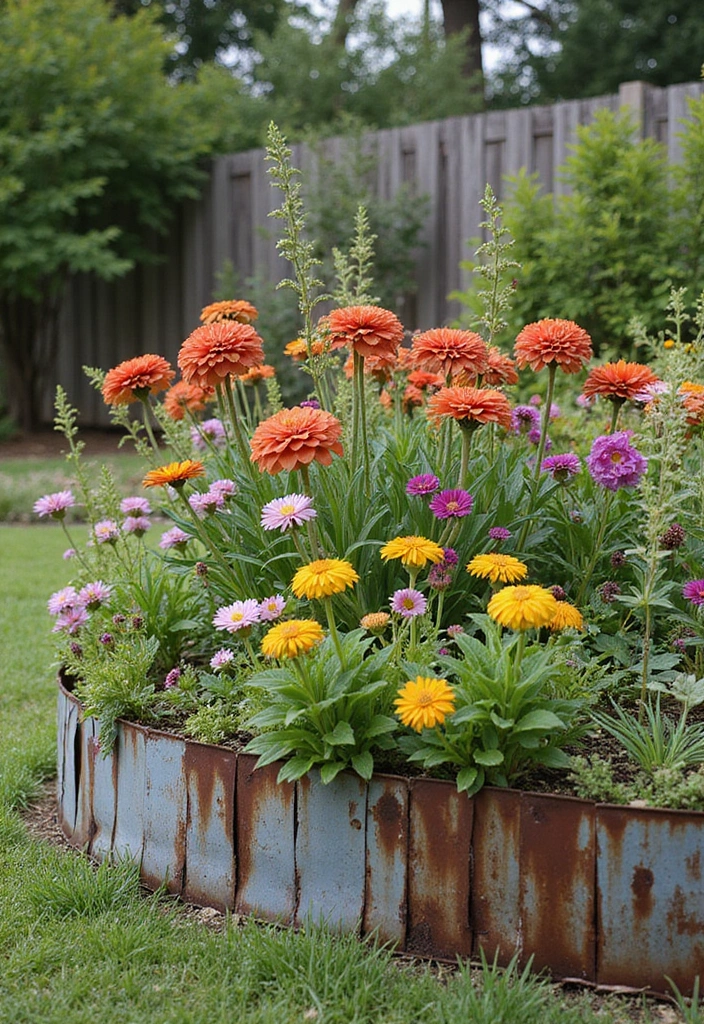
For a more industrial look, scrap metal can be an edgy choice for flower bed borders.
Old tools, pipes, or sheets of metal can be upcycled to form unique edges.
Benefits: Metal is highly durable and can withstand the elements, providing a long-lasting option.
Creative tip: Rusty or patinaed metal can add a vintage vibe that pairs beautifully with colorful flowers.
Ensure to check local regulations about using metal in gardens.
This option allows you to express creativity while being eco-conscious and budget-friendly!
25. Old Books or Magazines
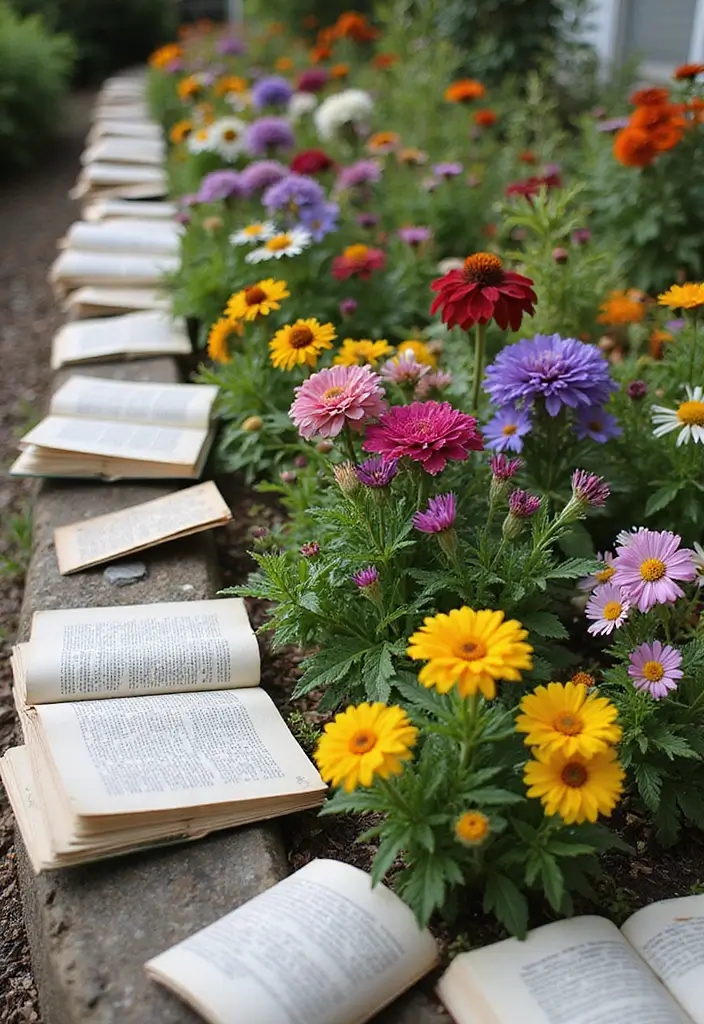
For the literary lovers out there, using old books or magazines as edging is a whimsical idea!
Create a barrier by layering them along the edge of your flower bed.
Why books? They can add a unique artistic flair to your garden while being an eco-friendly choice.
Maintenance: This option may require replacing pages as they deteriorate, but the charm is undeniable!
Consider using waterproofed books if you expect heavy rain.
This idea adds a touch of personality and creativity to your garden that’s sure to spark conversations!
26. Stone Troughs

Stone troughs, often used for feeding livestock, can make stunning flower bed borders.
These troughs have a rustic charm that adds character to any garden.
How to use: Set the troughs along the edge of your flower bed, filling them with soil and flowers for a beautiful display.
Durability: Stone is incredibly durable and will last for years, making this a worthwhile investment.
Creative tip: You can even use the troughs to plant herbs or vegetables alongside your flowers for a mixed garden bed.
Using stone troughs creates a charming and functional border that enhances any garden!
27. Fireplace Bricks

If you have leftover bricks from a fireplace project, they can be repurposed as edging for your flower bed.
These bricks add a warm, inviting look that complements a variety of flower types.
Installation: Lay them flat or stack them for a more defined border.
Creative advantage: You can even paint them to match your garden theme for a cohesive look.
This option is durable and helps create a clean and polished appearance in your garden.
Repurposing fireplace bricks adds character while keeping your garden design stylish and budget-friendly!
28. Woven Twigs
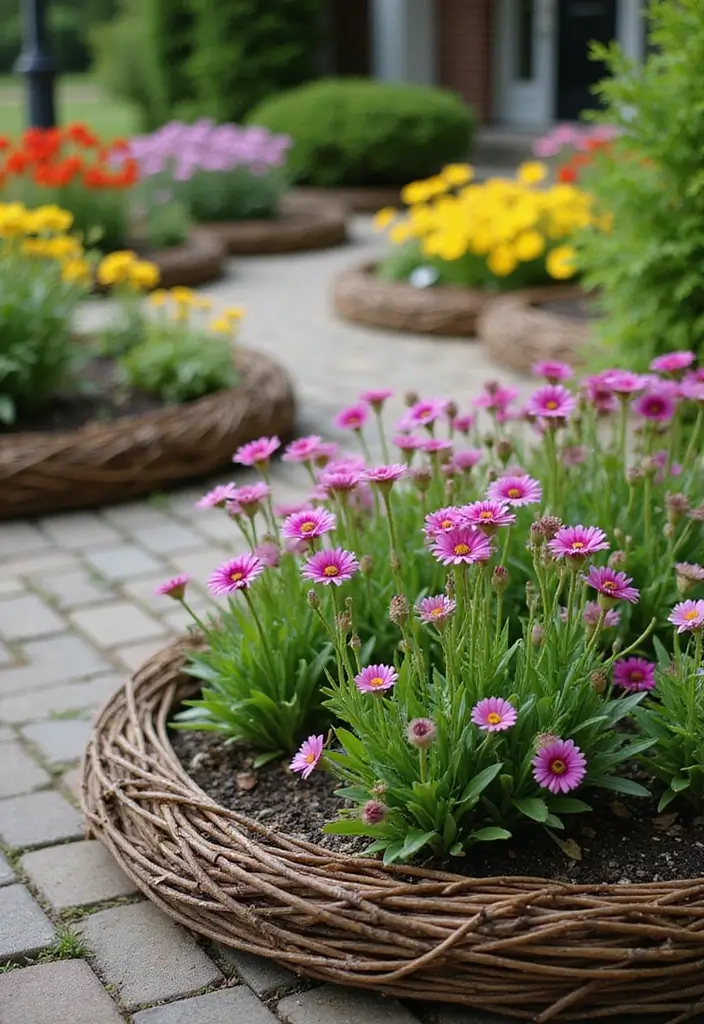
Woven twigs create a beautiful, natural edge around your flower beds.
Gather thin branches or twigs and interweave them to form a rustic fence-like border.
Benefits: This option is inexpensive, eco-friendly, and easy to shape to your liking.
Installation tip: Secure the twigs into the ground as you weave to maintain stability and structure.
This edging style not only preserves the natural beauty of your garden but also showcases your creativity.
Using woven twigs adds a whimsical and organic touch that’s sure to please visitors!
29. Painted Rocks

Using painted rocks as edging creates a delightful, personalized touch to your flower beds.
You can collect smooth stones and paint them in fun designs or colors that complement your garden’s theme.
Installation: Arrange the rocks along the edge of your flower bed, either flat or stacked, for visual interest.
Creative tip: Encourage kids or friends to join in on the painting process!
This engaging idea not only beautifies your garden but provides a charming and personal touch that reflects your style.
Painted rocks bring cheerfulness and creativity to your flower bed without a significant financial investment!
30. Hanging Planters as Edging

For a unique twist, consider using hanging planters as edging for your flower beds.
Place them along the border and fill them with cascading flowers or greenery to create a stunning visual effect.
Advantages: This option adds height and drama, making your garden stand out.
Installation tips: Ensure they are securely hung and can withstand wind and weather.
This creative idea turns traditional edging on its head, bringing a fresh and artistic approach to your flower bed design.
Hanging planters not only save space but also add a lively, eye-catching element to your garden!
Conclusion
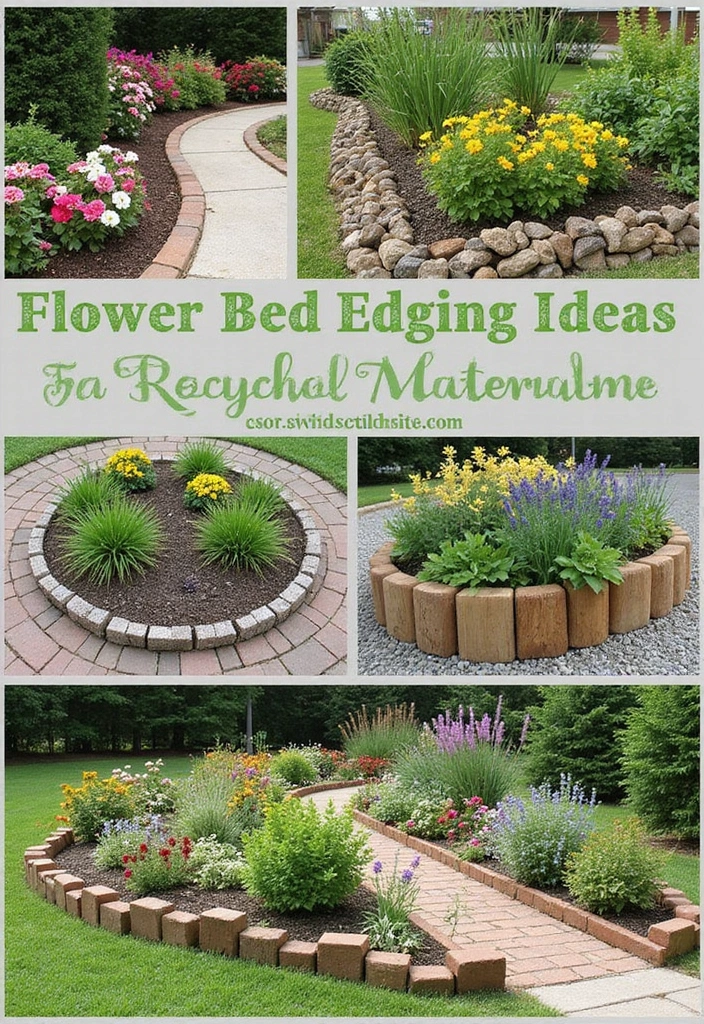
Creating beautiful flower bed borders doesn’t have to cost a fortune.
With these 30+ cheap flower bed edging ideas, you can find inspiration to transform your garden using recycled materials.
From old wood to colorful bottles, each idea adds its unique charm while staying budget-friendly.
Embrace your creativity, and let your garden shine with personal touches that tell your story!
Frequently Asked Questions
What are some of the cheapest materials I can use for flower bed edging?
You’d be surprised at how many budget-friendly materials you can use for flower bed edging! Options like upcycled wooden pallets, old tires, and recycled plastic bottles can all create stunning borders while being easy on your wallet. Explore your surroundings for materials that can be repurposed, and let your creativity shine!
How do I install DIY garden edging effectively?
Installing DIY garden edging can be a fun project! First, plan the layout of your edging by marking it with stakes or a garden hose. Then, prepare the ground by removing any grass or weeds. Depending on the material, you may need to dig a shallow trench. Finally, place your chosen material, ensuring it’s stable and visually appealing. Voila! You’ve just added a stylish touch to your garden.
Can I use recycled materials for decorative edging options?
Absolutely! Using recycled materials not only saves you money but also adds a unique charm to your garden. Think about using items like old books, wine bottles, or even seashells as decorative edging options. These materials can bring personality to your flower beds while also being eco-friendly!
What are the maintenance requirements for budget-friendly landscaping?
Maintaining budget-friendly landscaping is generally easier than you might think! Most recycled materials require minimal upkeep. For instance, wooden pallets may need occasional sealing, while stones or bricks just need regular weeding. Keeping the edges clear of debris will ensure they look their best. Regularly check for any damage, and replace materials as needed to keep your garden vibrant!
How do I choose the right flower bed borders for my garden style?
Choosing the right flower bed borders depends on the overall theme of your garden! If you prefer a rustic look, consider using bamboo stakes or logs. For a more whimsical vibe, painted rocks or old tires can add a pop of color. Think about the colors and textures in your garden, and select materials that complement them for a cohesive look.

